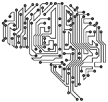by Joelle Steele

I first realized that I was ambidextrous when I was in the second grade and broke my left wrist. I didn’t know what it was called at the time, but I had always done things with both hands. Now that I had a broken left wrist, I had to write with my right hand too, and that’s when I discovered I could also write almost as well with my right hand.
Over the years, I found that I could even do mirror writing with my left hand. I have better fine motor control with my left hand. So, if I want my handwriting to be really pretty, I use my left hand, and in painting, I do the same, using my left hand for the finer details. This kind of distinction between hand use flows into almost everything I do.
I can use a hammer, a screw driver, and almost any tool equally well with both hands, including scissors. But, when I need strength, my right hand is the one I use, and there are some things that always require that strength. I used to play guitar, and I played left-handed. My pre-arthritis right hand could hold down the strings better to chord, but my left hand could pluck better. Oddly, I once tried out a boyfriend’s violin and immediately realized that if I played violin, I would have to play it right-handed, because more fingering is done with the left hand when it’s played right-handed. I could also play the flute left- or right-handed.
But then there’s baseball in which I bat left and pitch right, for no reason in particular, and I don’t even know if I can bat right-handed at all because it has never come up, but since I can sweep and rake left- or right-handed, I assume I can also bat right-handed equally well. I can play tennis with a racket in either hand. I can work a ten-key calculator by touch with either hand.
I can also do some things with both hands simultaneously, like painting and running a hand-held hair dryer (to dry the paint) at the same time that I’m manipulating that paint. Or I might be painting with a brush in one hand and working a palette knife or sponge in the other. The one place where being ambidextrous has paid off best for me is in doing online research where I work the mouse with my right hand while making notes on paper with my left.
Statistically, only ten percent of all people are left-handed and only one percent of people who are ambidextrous can write equally well with either hand. There is a also a greater incidence of high intellect in ambidextrous and left-handed people. Paul McCartney and Leonardo Da Vinci are two famous ambidextrous people. I’m not famous, but I do have a very high IQ at 186.
Back in the 1980s when I was having my brain analyzed again and again after a traumatic brain injury in a car accident, I ended up for a short time in a brain study of people who are ambidextrous. The brain was scanned while you were solving certain kinds of problems or answering 50 very different kinds of questions. The questions were designed with more than one correct answer, and how you answered indicated what part of the brain you used to solve the problem or formulate your answer in each question. In the end, I got the following evaluation:
“Right hemisphere responses, 3; Left hemisphere responses, 2; Integrated responses, 45. Your brain evidences very strong integrated hemisphere activity that gives you the ability to equally employ analytical/scientific and intuitional/creative approaches to problem solving. You can switch seamlessly from one to the other. You excel in daily activities because you can easily grasp the central issues in problems and you can plan detailed steps to reach goals. You are sensitive to both verbal and spatial relationships which allows you to develop and synthesize ideas. Your thinking and learning skills are extremely well integrated.”
I think that being ambidextrous and having a more symmetric or integrated brain may be the reason why I find it so easy to do things in both the arts and sciences equally well and to shift back and forth between those two kinds of thinking, as I do in writing fiction and non-fiction. Other than that, I can’t think of anything about being ambidextrous that is really earth-shattering news. I have met two people who lost their ability to use their right hands and had to learn to do things with their left hands, and one of them told me that it took him about a year to become a lefty. So, I think it’s very possible that anyone can become ambidextrous if they just use their less dominant hand more often. Practice makes perfect, right?
